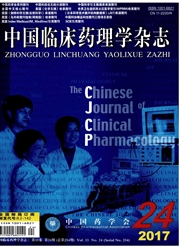

 中文摘要:
中文摘要:
目的研究7-二氟亚甲基-5,4’-二甲烷氧基异黄酮(dFMGEN)抗动脉粥样硬化(AS)的可能机制。方法6新西兰兔40只,随机抽取32只制作AS模型,余8只为正常对照组;造模60天后,32只分为模型对照组、dFMGE组、洛伐他汀组、金雀异黄素组,分别给予安慰剂及相应药物5mg·kg-1·d-1,治疗30天,测定治疗前后血清相关指标。结果与模型对照组相比,dFMGEN组一氧化氮(NO)水平升高(P〈0.01);内皮素(ET-1)、氧化型低密度脂蛋白(OX—LDL)水平降低(P〈0.01);同型半胱氨酸(HCY)水平无统计学差异。结论增加NO合成、减少ET-1释放及抗LDL—C氧化,可能与dFMGEN抗AS机制有关。
 英文摘要:
英文摘要:
Objective To investigate the potential antiatherosclerotic mechanism of 7 - difloromethyl - 5,4′ - dimethoxygenistein ( dFMGEN ) in atherosclerosis rabbits. Methods Thirty two New Zealand rabbits were randomly selected from forty male rabbits to make the atherosclerosis model, while the others were defined as normal controls. After sixty days making for model, the rabbits were divided into four groups: model control group (vehicle solvent 5 mg . kg-1 per day ), dFMGEN group (dFMGEN 5 mg . kg-1 per day), lovastatin group (lovastatin 5 mg . kg-1 per day) and genistein group (genistein 5 mg . kg-1 per day). They were treated for thirty days. Some indices of serum were detected and compared after feeding for 60 days and treatment for 30 days. Results Comparing with model control group, dFMGEN could significantly reduce the serum ET - 1 ,ox - LDL concentration (P 〈0. 01 ), increase the serum NO concentration (P 〈 0. 01 ). There was no significant difference of the HCY levels in each experimental group. Conclusion dFMGEN has potential antiatherosclerotic effects by affecting release of NO and ET - 1 and preventing oxidation of low density lipoprotein.
 同期刊论文项目
同期刊论文项目
 同项目期刊论文
同项目期刊论文
 期刊信息
期刊信息
